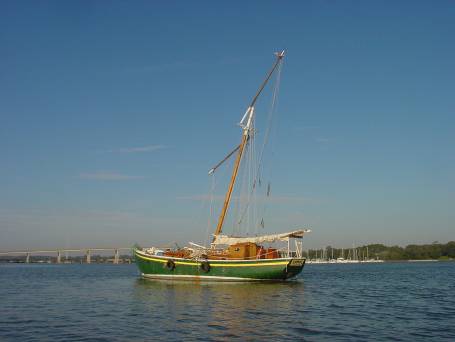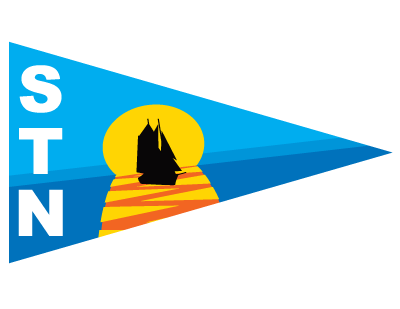[Publisher's note: The article below is strictly for our archival record as of February 2007, due to the Wanderer's unfortunate state of her hull and the removal of this project from Culture Change. The request for donations has been deleted. The announcement below of the launch of Sail Transport Network was premature at the time. Since then we have pursued other possibilities on both sides of the Pacific and in the Caribbean. In March 2009 we received corrected information on the Wanderer's builder, and edited the piece below accordingly. - Jan Lundberg, Publisher of Culture Change, March 2009]
Editor's note: We're happy to report that the long launch of the Sail Transport Network has proven successful. This article and proposal is about STN's first practical project, toward our goal of sustainable trade and transport powered by truly renewable energy. More news on STN will be forthcoming on the Culture Change website and at the San Francisco Petrocollapse Conference.
Proposal for the Refit of the Schooner Wanderer
The purpose of this proposal is to perpetuate the existence of the Schooner Wanderer, and to refit her as a freight vessel serving Central America and the United States for the Sail Transport Network.
The Wanderer is a replica of a 1903 Grand Banks Schooner, hand-built in 1985 at Trinity Bay, Newfoundland by Henry Thomas Vokey. She was originally named the J & B, after Henry Vokey's four daughters; Jane, Josephine, Bonnie and Bernice. She was Vokey's last tall ship project, his largest, and favorite. He will be 80 years old in October 2009, and he is still building sailboats.
She was a fishing vessel, and a buy boat, meaning she was the equivalent of a double trailer semi truck today. Her original itinerary would have been to run out in late winter and early spring to “bait the fields,” returning in late spring to fish the baited fields. In the early summer months, she would head south with a load of salt cod, bound for Brazil, and return in late autumn or early winter with a load of salt.  The Wanderer off Georgia
During the past 15 years, she was not well cared for, having been used as a sunset harbor cruise boat in Port Canaveral, Forida. Her masts were allowed to rot, and her decks were coated with resin, which accelerated rot below decks. In May of 2006, she was sold to a private owner who had intentions of converting her into a luxury yacht, but a month later she was struck by the outriggers of a shrimp boat, and dismasted. The new owner became frustrated by this, and sold the boat for a pittance. The Sail Transport Network purchased her in December 2006. She is currently anchored at Jekyll Island, Georgia. Pictured here is a photo of her in her current state.The rough estimate for her refit stands at around $1000 for replacement masts (one of which has already been donated to the project) and re-rigging, plus up to $10,000 for refitting the cabin and topsides for service as a freight vessel, finishing the crew's quarters, and adding some comfort items such as a stove. We would like to refit her to the level of a 1900's-era vessel, so that it would appear that you were looking into a time warp when you cast your gaze upon her, while still set up to be utilized as a commercial vessel. The initial project is to remove the resin from the decks, rebuild the cabin-tops, combining them into one long cabin-top rather than two small ones, and extend the pilothouse over the helm station. We also intend to remove the oversized Caterpillar diesel engine, and replace it with a Yawl Boat, a shippable outboard, or a smaller auxiliary engine. This will free up some space, which will be used as additional crew’s quarters and cargo space. After this evolution is completed, the refit of the crews quarters will begin, adding 10 bunks; 6 port, 6 starboard, and 2 forward, a full galley with a wood-burning stove, and a head with a shower.After the refit is done, she will be rechristened "The Emancipator" and begin service as the first freight schooner to serve the United States since 1938. We intend to haul fair-trade and organic coffee, offering lower delivery costs than the coffee distributors are currently paying. In time, this could serve to lower the retail cost of fair-trade and organic coffee, making it a viable alternative to coffee drinkers in the US. This will also prove the viability of sail as an alternative to diesel-powered overseas shipping, which is dependent on increasingly expensive and unreliable supplies of crude oil. The Wanderer will need about 3 months dry-dock time for a full refit. The cost of the dry dock is the largest single cost of the whole project. We need [deleted: request for donations] volunteers to help pound oakum into the hull, sand down the decks, and refit the interior. The refit is planned to occur in Darien, Georgia, where they are already familiar with the Wanderer's dimensions, and have previously hauled her out for maintenance. Her shakedown cruise will be to the Annapolis, Maryland, to participate in the Great Chesapeake Bay Schooner Race in October of 2007. Here, we hope to raise awareness of the Sail Transport Network's efforts, and the Wanderer’s (which will be The Emancipator by then) intentions as a commercial vessel. After the race, she will be sailed south to Panama, re-registered as a Panamanian vessel, and begin freight service, hauling fair-trade organic coffee from Central America to Corpus Christi and Houston, Texas. She will be able to lade coffee at a third to half the price of what is currently being charged, and get it there a just few days later than a motor freighter. Once she establishes a regular trade route, then more ships will be constructed in Valenca, Brazil, by a tribe of indigenous Brazilian natives, who have been constructing wooden ships to 16th through 18th century plans, and have been passing down tools from generation to generation. As more sailing vessels begin carrying freight, the idea of sail as a freight alternative will become more realistic....The first golden age of sail ended in 1940. The second golden age of sail ended in 1995. Help us ring in the third golden age of sail on the same winds as the first -- with trade and commerce. This is all a realistic possibility. If you are interested in contributing to Sail Transport Network, please contact us at info "at" culturechange "dot" org, with STN in the subject line. * * * * * More articles on STN on this website, by Dmitry Orlov:http://culturechange.org/cms http://culturechange.org/cms The first STN website: http://www.culturechange.org/sail_transport_network.htm Support the projects of Culture Change such as this website. Please visit: culturechange.org/funding.htm (A PayPal button is there for online, secure donating) To subscribe to the Culture Change Letter and get on the subscriber list, please visit: http://lists.mutualaid.org/mailman/listinfo/culturechange  Burgee by Dmitry and Matt
|
|||
 |
||
|
|
